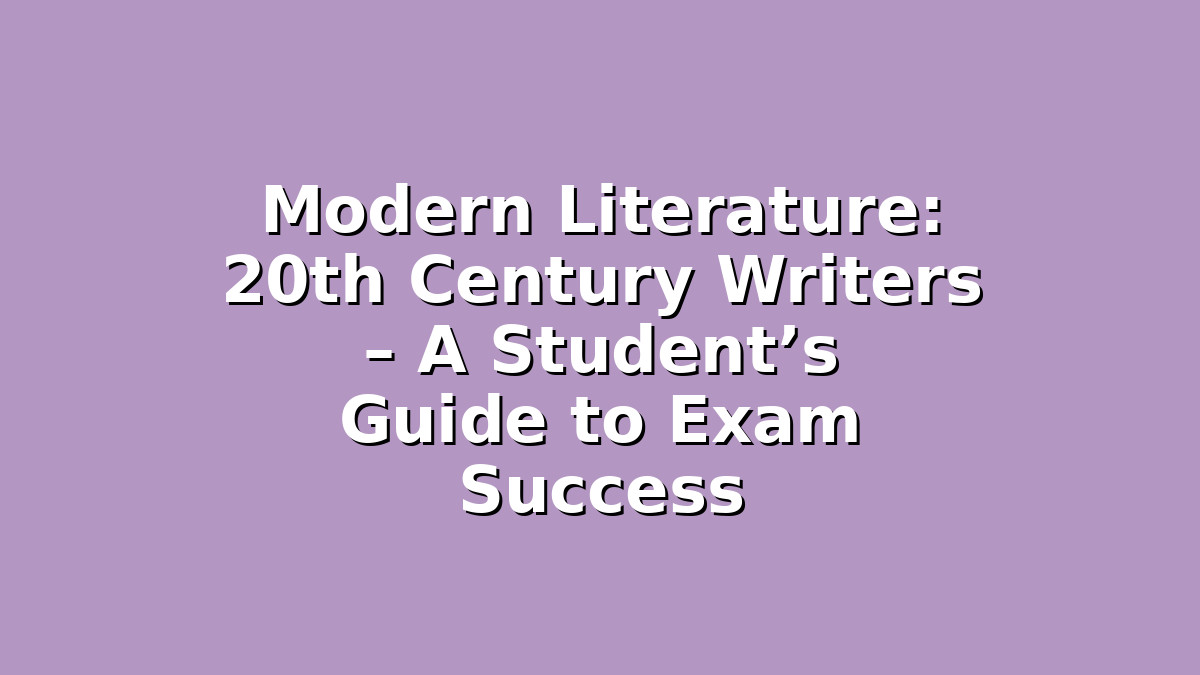When preparing for exams, especially in literature, understanding the key authors and movements of the 20th century can feel overwhelming. Modern literature, particularly from the 20th century, is rich with influential writers who challenged traditional forms and explored new themes reflecting a rapidly changing world. For students studying English literature or world literature, mastering the works and contexts of these writers is essential. This guide will help you break down the landscape of 20th-century literature and provide practical tips to prepare effectively for your exams.
Introduction to 20th Century Modern Literature
The 20th century was a time of tremendous social, political, and technological change, and literature from this period mirrors these shifts. Modernist writers like James Joyce and Virginia Woolf experimented with narrative techniques, while later writers like George Orwell and Toni Morrison tackled political and social issues head-on. Understanding modern literature means grasping the diversity of styles and themes that define the century’s literary output.
For students, studying 20th-century literature isn’t just about remembering facts or plot summaries—it’s about engaging with complex ideas and critical perspectives. To help you succeed, let’s explore three key areas: understanding major authors and movements, analyzing themes and literary techniques, and developing effective study habits.
—
1. Understanding Major 20th Century Authors and Literary Movements
The first step in preparing for exams is to familiarize yourself with the significant writers and movements of the century. Here are some important figures and their contributions:
– Modernism (early 20th century): Modernist writers sought to break away from the strict forms of 19th-century literature. Key authors include:
– *James Joyce*: Known for *Ulysses*, he used stream-of-consciousness to depict the inner thoughts of characters.
– *Virginia Woolf*: Her works like *Mrs. Dalloway* focus on psychological depth and fluid narrative perspectives.
– *T.S. Eliot*: A poet whose works, such as *The Waste Land*, symbolize fragmentation and disillusionment after World War I.
– Postmodernism (mid to late 20th century): Postmodernist literature often questions objective truths and embraces irony and playfulness.
– *Kurt Vonnegut*: Known for blending satire with science fiction in works like *Slaughterhouse-Five*.
– *Margaret Atwood*: Explores gender and power dynamics, for example in *The Handmaid’s Tale*.
– Social and Political Literature:
– *George Orwell*: His novels *1984* and *Animal Farm* critique totalitarianism and political oppression.
– *Toni Morrison*: A key figure in African American literature, Morrison’s works such as *Beloved* address identity, history, and trauma.
Study Tip: Create a timeline or mind map linking authors, their major works, and the historical context. This visual aid helps you see connections and remember key facts. Try to include brief notes on themes and narrative style for each author.
—
2. Analyzing Themes and Literary Techniques: What Examiners Really Want
Examiners often focus on your ability to discuss themes and literary techniques rather than just summarizing plots. When studying, aim to recognize common themes and how different authors use language to convey them.
Key Themes in 20th Century Literature:
– Alienation and Fragmentation: Reflecting the anxieties of modern life, many writers explore how individuals feel isolated or disconnected from society. For example, T.S. Eliot’s poetry often illustrates a fragmented modern world.
– Identity and Race: Writers like Toni Morrison delve into issues of racial identity and cultural heritage.
– Political Oppression: Orwell’s dystopian novels explore how power can corrupt and control.
– Gender and Sexuality: Virginia Woolf and Margaret Atwood examine the roles and restrictions placed on women.
Important Literary Techniques:
– Stream of Consciousness: A narrative style that attempts to capture the flow of a character’s thoughts (e.g., Woolf, Joyce).
– Symbolism and Imagery: Used to convey deeper meanings beyond the literal text (e.g., Eliot’s use of the wasteland as a metaphor for societal decay).
– Irony and Satire: Often employed to critique social and political issues (e.g., Vonnegut’s dark humor).
– Non-linear Narratives: Stories may not follow chronological order, requiring careful reading and interpretation.
Study Tip: When revising, practice identifying these themes and techniques in your set texts. Make flashcards with examples and explanations to test yourself. Also, write brief analyses of key passages, focusing on how writers use language to develop themes.
—
3. Effective Study Habits for Mastering 20th Century Literature
Studying literature requires a balance of reading, note-taking, and critical thinking. Here are some strategies tailored to 20th-century literature:
Active Reading:
Don’t just passively read your texts. Annotate as you go, highlighting passages that illustrate key themes or techniques. Write questions or comments in the margins to engage with the text.
Group Discussions:
Join or form study groups where you can discuss interpretations and hear different perspectives. 20th-century literature often has multiple layers, and talking about these can deepen your understanding.
Practice Past Papers and Essay Writing:
Exams often require essay-style answers. Practice writing clear, concise essays that include:
– A strong thesis statement.
– Textual evidence supporting your points.
– Analysis of literary techniques.
– Consideration of historical and cultural context.
Use Supplementary Resources:
Watch documentaries, listen to podcasts, or read critical essays on 20th-century literature. These resources can provide context and different viewpoints that enrich your understanding.
Time Management:
Allocate study time based on your exam syllabus. Break down your revision into manageable chunks, dedicating specific days to authors or themes. Use tools like calendars or revision apps to track your progress.
Study Tip: Set SMART goals (Specific, Measurable, Achievable, Relevant, Time-bound) for your revision sessions. For example, “Today, I will analyze three passages from *Mrs. Dalloway* focusing on stream of consciousness and symbolism.”
—
Conclusion
Mastering 20th-century modern literature is an achievable goal with the right approach. By familiarizing yourself with key authors and movements, focusing on themes and literary techniques, and adopting effective study habits, you will gain confidence and depth in your understanding. Remember, literature is not just about memorization—it’s about engaging with ideas and developing your critical thinking skills. Stay curious, practice regularly, and approach your revision with a positive mindset. Your hard work will pay off in your exams and beyond.
Good luck!

Responses